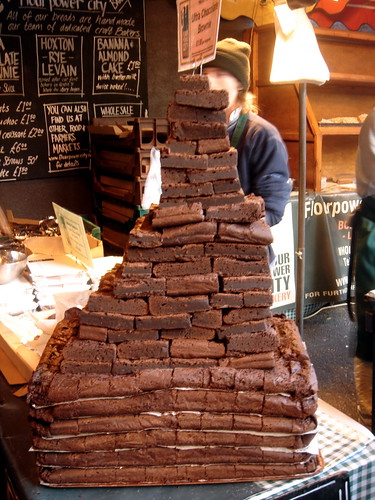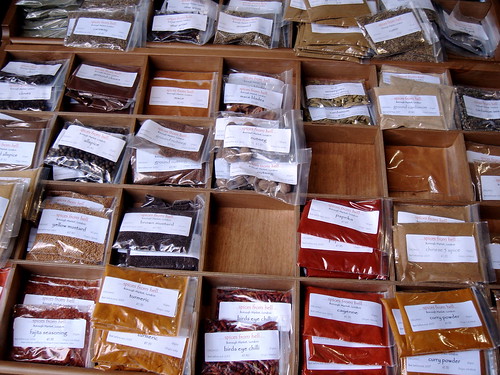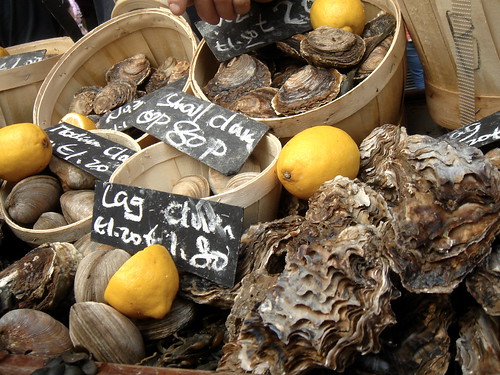
Every weekend, at the southern end of London Bridge, hundreds upon hundreds of Londoners, tourists, and food enthusiasts of all shapes and sizes, gather to taste and explore the gastronomic delicacies offered in London's famed Borough Market. So what is it that makes this particular market a cultural phenomenon, hailed by celebrity chefs, and setting it apart as one of the most famous food markets in the world? If 4.5 acres of Britain's finest local produce and artisan foods - such as black truffle terrines, towering mounds of award winning cheeses of every shape, taste, and texture, air-dried cumbrian lamb, buckets of olives and gourmet olive oils, wild boar steaks, mammoth sized ostrich eggs, English apple cider, beers from around the world, fine French winse, fresh organic breads, hand shucked oysters, fois gras, and hand made cocoa dusted truffles - aren't enough for you, then there is always the history behind it.

The history of Borough Market can be traced back to AD 43 when the Romans, led by Aulus Plautus, en route to sacking the city discovered the market on south bank of the Thames. There the Romans built the first London Bridge and whilst the Romans were followed by various successors, Borough Market continued to grow and flourish, welding itself into the bustling scene around the bridge. However, by 1272 the traffic from the market was becoming a rather significant nuisance, causing major congestion problems on London Bridge. A few hundred years later, Edward III passed a series of Royal Charters (in 1406, 1442 and 1462), moving the market a few hundred meters up and along the south side of the bridge to little or no effect. Apparently, road-rage from around the area helped deposit more than a few residents into two of London's most infamous prisons -The Clink and The Marshalsea. The poor City of London, thoroughly frustrated and exhausted, petitioned Parliament in 1754 to remove from themselves the responsibility of controlling the area. In 1756, an Act of Parliament granted the parishioners of St. Saviors church to move the market to its current location.

The history of Borough Market can be traced back to AD 43 when the Romans, led by Aulus Plautus, en route to sacking the city discovered the market on south bank of the Thames. There the Romans built the first London Bridge and whilst the Romans were followed by various successors, Borough Market continued to grow and flourish, welding itself into the bustling scene around the bridge. However, by 1272 the traffic from the market was becoming a rather significant nuisance, causing major congestion problems on London Bridge. A few hundred years later, Edward III passed a series of Royal Charters (in 1406, 1442 and 1462), moving the market a few hundred meters up and along the south side of the bridge to little or no effect. Apparently, road-rage from around the area helped deposit more than a few residents into two of London's most infamous prisons -The Clink and The Marshalsea. The poor City of London, thoroughly frustrated and exhausted, petitioned Parliament in 1754 to remove from themselves the responsibility of controlling the area. In 1756, an Act of Parliament granted the parishioners of St. Saviors church to move the market to its current location.
These days Borough Market is a registered Charity organization, run by a board of Trustees, with the aim of "providing relief of the rates for the inhabitants of the parish of St Saviour’s (Southwark Cathedral)." Recently, the market celebrated 250 years of trading at its current site and indeed it has much to celebrate. Not only is it widely recognized as the "Best Market in the Country", Borough Market is rapidly becoming a well know foodie-desination around the world.
Indeed the market is full of charm, if it were a man I'd marry it in a second. What with its bustling english vibe, merchants lined side by side , customers crammed into each other, each vying for that last parcel of hand picked morel mushrooms, the energy of the place filling your head with a pleasant buzz - or is that the sugar high from consuming one too many strawberry tarts and turkish delights? On gorgeous sunny days the bars spill out with people of all ages, pint in one hand and maybe a delectible little nibble from the market in the other. And with spring having come upon London almost overnight, beautiful fresh cut flowers, with their vibrantly coloured blooms, have been added to the great many other treasures one can find in the Market.
All the public accolade and atomospheric allure aside, however, in the end it comes down to the one basic element that started it all - the food. Without the dedicated merchants of Borough, who each believe so strongly in providing only the freshest produce, sourcing the best ingredients, and their focus on quality over quantity, the market would not consistently draw and encourage initial visitors, such as myself, to make themselves, or wish themseles, a regular.

